Weekly Topics/Archive
September 2021 |
Today is the Respect-for-Senior-Citizens Day, the last day of the three
consecutive
holidays in autumn.
Three days ago, my wife told me that she wanted to go to a nearby hot spring
and relax.
So I searched the internet for hot spring inns near Lake Biwa.
But all of them were either closed due to the Corona or fully booked.
This is no wonder, since it is almost impossible to make a reservation
for tomorrow or the
day after tomorrow today.
[Note] Kosatsu ; 高札(street bulletin board)、 hunt down ; 追跡して捕まえる
hunt down and kill ; 追討する、 Yoshimune ; 徳川慶喜、 bulletine ; [官公庁からの]公報、公示
Respect-for Senior-Citizens Day ; 老人の日、 consecutive holidays ; 3連休
search the internet for 〜 〜を求めてネット検索する、 be fully booked ; 予約で一杯(満室)である
This is no wonder, since 〜 ; それもそのはず[since以下]だからです、
これは驚くべきことではありません。なぜなら[since]以下だからです。
Just in case, when I searched for the Lake Biwa Hotel on the Net, it was
very surprised to
find that one room was vacant.
I have been to this hotel in the past and knew there was a hot spring.
Immediately, I made a reservation for one night from September 20th on
the net.
Now that I have fulfilled my wife's wish, I want to fulfill my wish this
time.
My wish is to see the Kosatsu displayed at the Kashiwabara Inn History
Museum in
Kashiwabara, Maibara City, Shiga Prefecture.
When I told her about it, her answer was why it is fun to see such a thing.
She reluctantly accepted my wish when I was making a reply like a Zen mondo
(Zen riddle)
that I would go to see it because I wanted to see it.
In the end, we decided to go to the hot spring after seeing the Kosatsu.
[Note] just in case ; 念の為、 now that 〜 ; 今や〜だから、〜からには
fulfill one's wish ; 願いを叶える、 reluctantly ; 渋々、嫌々ながら、have a comeback
Zen mondo(Zen riddle) ; 禅問答、 in the end ; 結局、最後には
That Tokugawa Yoshinobu that appears in the NHK Taiga drama “Reach beyond
the blue
sky” that you know.
I knew in the newspaper that the kosatsu (bulletin board) ordering to hunt
down and kill
Yoshinobu, who lost in the Battle of Toba-Fushimi in 1868 (the 4th year
of Keio) was
exhibited at this history museum.
For your information, kosatsu is the wooden plate on which the laws, bans,
criminal
charges, etc. were written mainly in the Edo period.
It was put up at the places such as busy street corner and square to notify
the public of them.
[Note] NHK Taiga drama ; NHK大河ドラマ、 Reach beyond the blue sky ; 晴天を衝け
Battle of Toba-fushimi ; 鳥羽・伏見の戦い、 ban ; 禁令、禁制、 criminal charge ; 犯罪人の罪状
put up 〜 ; 〜を掲げる、掲示する、 notify -- of 〜 ; -- に〜を知らせる(告示する)
Kashiwabara, Maibara City, Shiga Prefecture, where the histoly museum is located,
is the town located at the southern foot of Mt.Ibuki, which is adjacent
to Sekigahara town,
Gifu Prefecture.
Mt.Ibuki has long been known as a mine of medical plants, and moxa made
from mugwort (yomogi in Japanese) was a special product of this town.
It was 11:44 when we left JR Kusatsu Station, changed trains at JR Maibara
Station, and
arrived at the third JR Kashiwabara Station.
We were the only passengers getting on and off the train, and there was
no one in front of
the station and it was quiet.
[Note] adjacent to 〜 ; 〜に隣接する、 moxa ; もぐさ(艾)、 mugwort (yomogi) ; ヨモギ
a mine of 〜 ; 〜の宝庫、 change trains ; 電車を乗り換える
passengers getting on and off the train ; その駅の乗降客
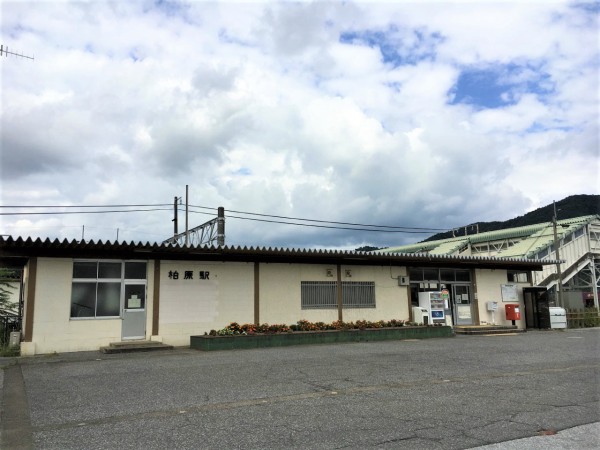 |
| JR Kashiwabara Station (JR Tokaido Line) (2021.09.20_11:54) |
I went to Nakasendo near the station according to “Nakasendo Kashiwabare-juku
walking map” that was placed at the station.
It is the highway lined with old houses that convey the atomosphere of
the old post town.
Perhaps because it was around lunchtime, there was almost empty on the
road, and it was
so quiet that cars rarely passed by.
[Note] Nakasendo (Central Mountain Route) ; 中山道
(Nakasendo means Nakasendo highway or Nakasendo Road,)
Kashiwabara-juku ; 柏原宿、 lined with houses ; 家々が並んでいる、家々が連なる
convey the atomosphere of 〜 ; 〜の雰囲気を伝える [convey ; (情報などを)伝える]
post town ; 宿場町、 perhaps because 〜 ; 〜のためか、〜のせいか、 pass by ; 通り過ぎる
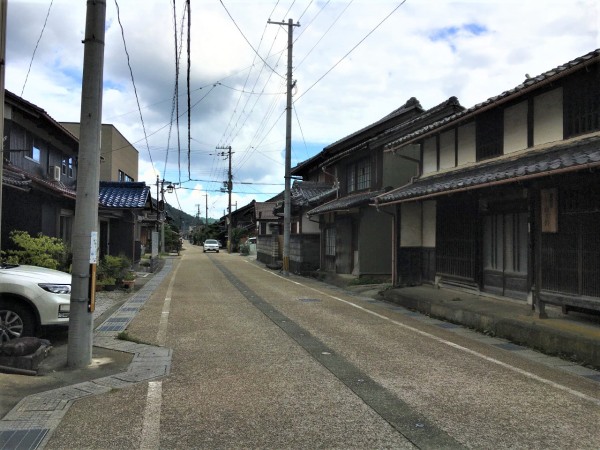 |
| The streetscape of the old Nakasendo where Kashiwabara-juku used to be (2021.09.20_11:56) |
Let me explain about Kashiwabara-juku briefly.
| Kashiwabara-juke on Nakasendo |
Kashiwabara-juke was the sixtieth post station of the 69 stations of the
Nakasendo
from Edo (Nihonbashi) in Edo period.
Among the 4 stations in south Mino and 8 ones in Omi, it was the longest
station with
a length of about 1.4Km and the highest one with an altitude of about
180m.
And also it had a population of 1468 people in 344 houses, including one
honjin,
one waki-honjin, and 22 hatago.
At its peak, it seems to have been a busy post station lined with about 10 shops
selling the famous moxa.
(Reference) 「柏原宿への誘い(Invitation to Kashiwabara-juku)」(柏原宿歴史館
(Kashiwabara-juku History Museum)) |
[Note] streetscape ; 街路の風景、街並み、 post station ; 宿場町
the 69 station of the Nakasendo ; 中仙道69次、 honjin ; 本陣、 waki-honjin ; 脇本陣
hatago ; 旅籠、 moxa ; (灸に使う)もぐさ、
The locations of the 69 stations of the Nakasendo are as shown in the
Google map below.
|
| The map of the 69 stations of the Nakasendo (2021.09.28) |
When you walk along the old Nakasendo, you can see traditional buildings
that convey
the remnants of the Edo period.
The following is the site of Toiyaba.
Toiyaba were administrative offices in post stations on highways during
the Edo period,
which mainly dealt with relays of riders and horses as well as sukego fuka
(labor from the
neighboring villages to help the primarily imposed village)
Pls click the picture to see a full-size version.
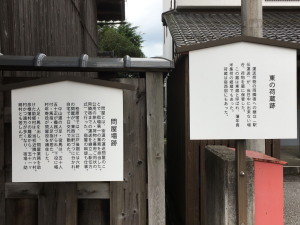 |
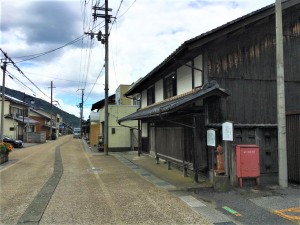 |
Explanation board about Toiyaba
(2021.09.20_11:58) |
The site of Toiyaba (right house)
(2021.09.20_12:00) |
[Note] convey the remnants of 〜 ; 〜の面影を伝える、 Toiyaba ; 問屋場
administrative office ; 管理事務所、 deal with 〜 ; 〜に取り組む、に対処(を処理)する
sukego fuka ; 助郷賦課、 imposed ; (義務などを)賦課された、課せられた
The following are the sites of Hatagoya.
According to Nakasendo-Syukuson-Taigaicho (中仙道宿村大概帳) published in 1843 (the 14th
year of Tenpo), Kashiwabara-juku was busy with 22 Hatagoya and many different
types
of shops around them.
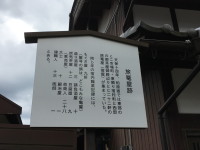 |
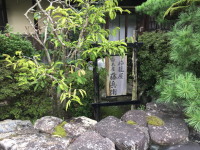 |
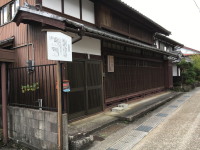 |
Explanation board about the site
of Hatagoya (2021.09.20_11:58) |
The site of Hatagoya “Shirakiya
Toubee” (2021.09.20_12:01) |
The site of Hatagoya “Kyomaruya
Gohee” (2021.09.20_12:03) |
The following is the site of waki-honjin.
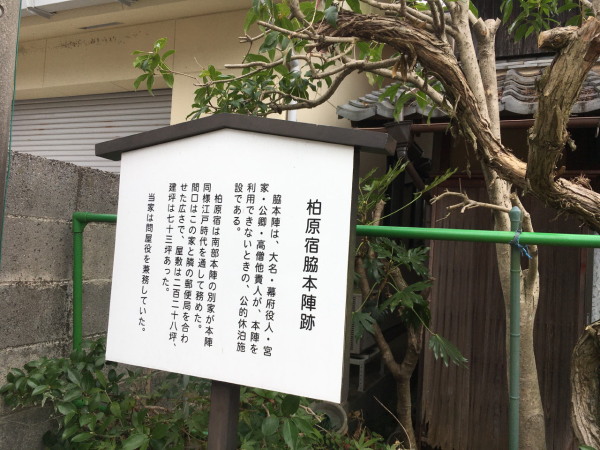 |
| The site of waki-honjin (2021.09.20_12:02) |
The following are the sites of sake breweries.
According to other explanation board, there were 3 sake breweries in this
post station.
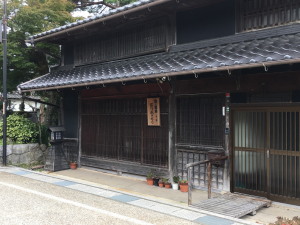 |
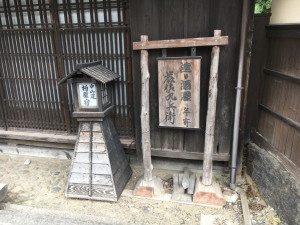 |
The site of sake brewery Nishikawa Seuemon
(2021.09.20_12:03) |
The site of sake brewery Iwasa Kyubee
(2021.09.20_12:12) |
The followin is an explanation board about the Nakasendo Kashiwabara-juku.
There is a signboard saying “Toiyaba officer toshiyori Yoshimura Kozaburo”
on the right side of it.
According to it, this is the site of the family home of Yoshimura Kozaburo,
a movie director
from the Showa period, and his grandfather was the last shoya in Kashiwabara.
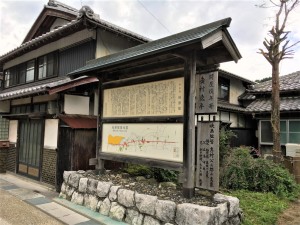 |
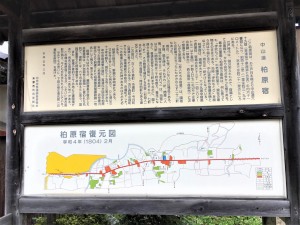 |
| The explanation board about the Nakasendo Kashiwabara-juku (2021.09.20_12:04) |
The following is the site of honjin in Kashiwabara-juku.
According to the explanation, the honjin is the public facility for resting
or lodding used by
people of high standing such as daimyo (Japanese feudal lord), shogunal
officials, miyake,
lords, and high priests.
The Nanbu clan acted as owner of the honjin in Kashiwabara-juku throughout the Edo
period.
The frontage of the honjin was 26 ken (about 52 m2), and the mansion was 526 tsubo and
the floor area was 138 tsubo.
The building is said to have been newly built before Princess Kazu stayed there.
It is written that the 14th Shogun Tokugawa Iemochi (husband of Princess Kazu) also
stayed in 1865 (the 1st year of Keio) on the way to the 2nd Choshu expedition.
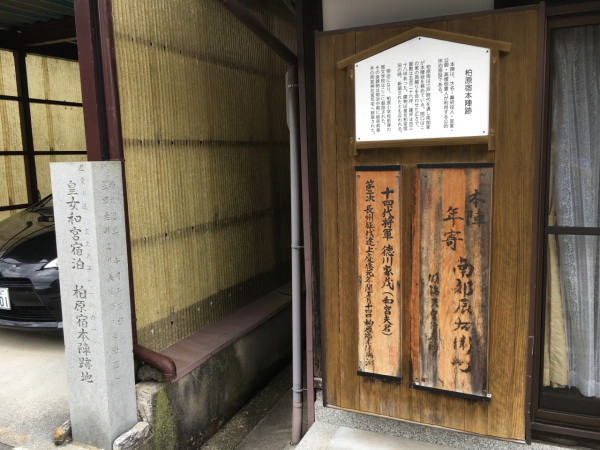 |
| The site of the Kasiwabara-juku honjin (2021.09.20_12:06) |
[Note] lodge ; 宿泊する、 noble; 貴人、 daimyo (Japanese feudal lord) ; 大名
feudal ; 封建制度の、 shogunal official ; 幕府役人、 lord ; 公卿
miyake (a branch of the Imperial Family) ; 宮家、 Nanbu clan ; 南部家(一族)
act as - in 〜 ; 〜で - を務める、 frontage ; 間口、 mansion ; 屋敷、 floor area ; 建坪
ken ; 間(One ken is about 1.82 m.)、 tsubo ; 坪(One tsubo is about the same
as 3.3 m2.)
Tokugawa Iemochi ; 徳川家茂、 2nd Choshu expedition ; 第2次長州征伐(expedition ; 遠征)
The following is the site of Kosatsu-ba.
This is the place where the Kousatsu for hunting down and killing Tokugawa
Yoshinobu
was put up.
The night-light at the foot of the Ichiba-gawa river still remains.
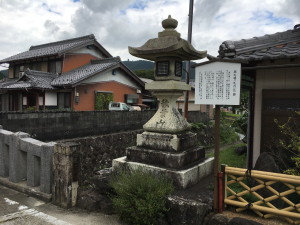
|
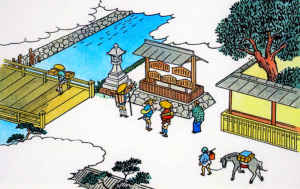
(Reference) The Asahi Shimbun Digital
(presented by Kashiwabara History Museum) |
The night-light remaining near the site of
Kosatsu-ba (2021.09.20_12:09) |
The imaginary picture of Kousatsu-ba
in Kashiwabara-juku |
We can see an old private house with lattice-windows on the left just
after crossing the river.
That is Ibukido Kameya Sakyo Shoten famous for Ibuki moxa, which a big
signboard of
“Ibukido” was puting out.
It is well-known as a long-established shop that has been in business for
350 years.
The storefront scenery was drawn in “The 69 stations of Kiso-kaido・Kashiwabara”
by
Hiroshige Utagawa published in 1835, and it still retains its appearance.
It's said there were 9 moxa shop in the post station at its peak.
At present, Ibukido is the only shop that is still open.
Unfortunately, it was closed because today was a holiday.
[Note] kosatu-ba(the place Kosatsu was put up) ; 高札場、 night-light ; 常夜灯、
imaginary picture ; 想像図、 lattice-window ; 連子窓
Ibukido Kameya Sakyo Shoten ; 伊吹堂亀屋佐京商店、 in business for 〜 years ; 創業 〜 年の
storefront ; 店頭、retain its appearance ; 外観を保つ、佇まいを残す(retain ; を保っている、持ち続ける)
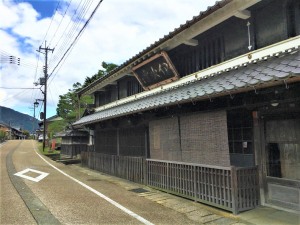 |
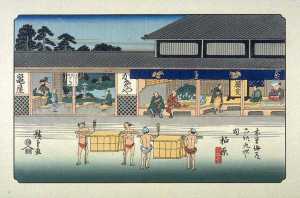
(Reference) Wikipedia/Kashiwabara-juku |
The appearance of Ibukido Kameya Sakyo
Syoten (2021.09.20_12:12) |
Ibukido Kameya Sakyo Syoten drawn in the 69
stations of Kiso Kaido・Kashiwabara
(2021.09.20_12:12) |
There was kashiwabara History Museum when we walked about 400m from the
JR
station.
We paid 250 yen per head as an admission fee, got a pamphlet “Invitation
to
Kashiwabara-juku”, and entered the museum.
According to the pamphlet, the museum was opend as a base for preserving
and displaying historical materials under the theme of Kashiwabara-juke,
but also disseminating information on the surrouding cultural heritage.
[Note] preserve ; を保存する、 disseminate ; (情報、思想などを)広める
cultural heritage ; 文化遺産
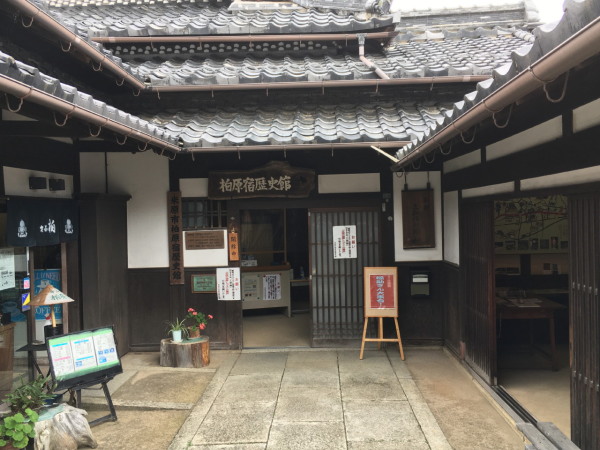 |
| Kashiwabara-juke History Museum (2021.09.20_12:14) |
There was exhibition rooms in the earthen storehouse (storehouse with
thick mortal walls)
when we walked into the back after watching the video about Kashiwabara-juku
at the video
corner.
Various historical materials about Kashiwabara-juku are exhibited.
I found it!!!
It is the Kosatsu about a decree to hunt down and kill Yoshinobu Tokugawa,
which I wanted
to see.
(Since photography was prohibited inside the room , the photo below was
reprinted from
the free leaflet “Kosatsu in the end of Edo period and the biginning of
Meiji Restoration”.)
[Note] earthen storehouse ; 土蔵 (earthen ; 土で作った, storehouse ; 倉庫)
walk into the back ; 奥へ進む、 I found it!!! ; 見つけた! 、あった! decree ; 布告、令
reprint ; 転載する、 Meiji Restoration ; 明治維新 (restoration ; 元の状態に戻すこと、復古)
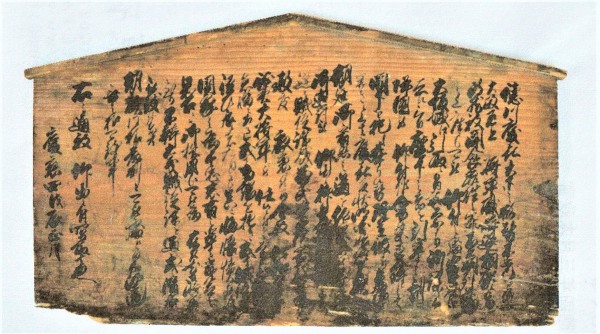 |
| Kosatsu “A decree to hunt down and kill Yoshinobu Tokugawa” (2021.09.29)
|
On Jan 3, 1868 (the 4th year of Keio), the Boshin War began with the battle
of
Toba-Fushimi, where the Shogunate army and the allied army of Chosyu and
Sastuma
domains clashed.
The Shogunate army was routed in the opening battle of Toba-Fushimi.
On Jan 6, Yoshinobu, who escaped from Osaka Castle, secretly left for Edo
on the
Kaiyomaru, a warship of the Shogunate.
On Jan 7, the new Meiji government issued the statement, “A decreet to
hunt down and kill
Yoshinobu”, which began with “Returning the ruling power to the Imperial
Court, realizing
that Yosinobu could not overturn the current situation”.
It is difficult for me to decipher the original sentence of the decreet.
According to the leaflet, its republication (Note.2) is as follows.
(Note.2) Republication means deciphering of handwritten chracters in classical
and ancient
documents and replacing with modern characters.
[Note] Boshin War ; 戊辰戦争、 battle of Toba-Fushimi ; 鳥羽・伏見の戦い
Shogunate army ; 幕府軍、 allied army ; 同盟軍、 domain ; 藩、 rout ; 敗走させる
warship ; 軍艦、 issue ; 発布(発令)する、 riling power ; 統治権、 Imperial Court ; 朝廷
overturn ; ひっくり返す、覆す、 decipher ; 判読する、 republication ; 翻刻
handwritten ; 手書きの、 ancient document ; 古文書
「徳川慶喜天下之形勢不止得ヲ察シ大政返上 将軍職辞退相願候旨断然被聞食既往之
罪不被問列藩言上座ニも可被 仰付之処豈図哉大阪城江引取之旨素より詐謀ニ而去ル
三日麾下之者を引率し剰へ帰国被仰付候会桑等先鋒として閣下を犯し葬り候勢現在彼より
兵端を開き候上者慶喜反状明白始終奉欺 朝廷御宥恕之道も絶果不被為為得己
御追討被仰出侯兵端既ニ相開候上者速ニ賊徒誅伐萬民塗炭之苦を被為 救度叡慮ニ
候間今般仁和寺宮征夷大将軍ニ付而者是迄偸安怠情ニ打過或者両端を抱き或者賊徒ニ
従ひ臣下之者たりとも真ニ悔悟憤発国家之為尽忠志有之輩者寛大之思召ニ而御採用ひ
可被為在候是御時節ニ至り不辨大義賊徒謀を通シ在者潜居為到被候者共 朝敵同様
厳刑ニ可被處候間心得無之様可致事
右之通被仰出ニ付聞取者也
慶應四戊辰正月 」
(出典)柏原宿歴史館 リーフレット「常設展示の逸品 幕末維新の高札」 |
According to modern translation, the decreet begins with the sentence
“Yoshinobu
Tokugawa offered the return of the ruling power to the Imperial Court and
declination
of the Shogunate, realizing that the current situation was inevitable,
and so Imperial Court
passed over his past sins and even asked him to be a senior member of the
domains.”
And then it continue with the sentence “In fact, since the battle was
started by Yoshinobu,
his intention to rebel was clear, and (snip) the Imperial Court could not forgive his sins
with a generous heart, and so was forced to hunt down and kill him
[Note] modern translation ; 現代語訳、 declination ; 辞退、 inevitable ; 避けられない、不可避の
pass over ; 大目に見る、不問に付す、 senior member ; 上級の地位のメンバー、高官
sin ; 罪、 intention ; 意思、 rebel ; 反逆(謀反)する、 (snip) ; 中略、 generous heart
; 寛大な心
be forced to do 〜 ; 〜せざるを得ない
And on the reverse side of the Kosatsu, another decree “Gobo no keiji
(The Five public
Notices #1: Adherence to the five relationships of Confucianism” was written.
The new Meiji government that issued “Charter Oath of Five Articles” on
Mar 14,1868
(the 4th year of Keio) issued an edict of Dajokan “Gobo no keiji”to the
area under the
new government on the following day.
The contents still followed the ones promulgated by the Tokugawa Shogunate,
but this
Kosatsu is the first of the five notices and the notice “Adherence to the
five relationships of
Confucianism” was written on it.
[Note] Gobo no keiji (The Five public Notices) ; 五榜の掲示、
adherence to 〜 ; 〜の遵守、 Five relationships of Confucianism ; 儒教の五倫
Confucianism ; 儒教、 Charter Oath of Five Articles ; 五箇条のご誓文、charter ; 勅書、憲章
oath ; 誓約、誓約書、 issue an edict ; (政府などが)布告をする、 Dajokan ; 太政官、
promulgate ; (法律を)交付(発布)する
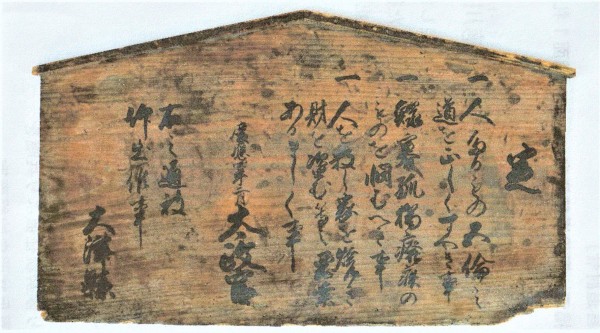 |
| Kosatsu “Gobo no keiji” (2021.09.29) |
The republication of the above Kosatsu is as follows.
「 定
一 人多るもの五倫之
道を正しくすべき事
一 鰥寡孤獨廢疾の
ものを恫むべき事
一 人を殺し家を焼き
財を盗む等之悪業
あるまじく事
慶應四年三月太政官
右之通被
仰出候事
大津縣 」
(出典)柏原宿歴史館リーフレット
「常設展示の逸品 幕末維新の高札」 |
|
Anyway, it is dificult to understand Japanese written language in the
beginning of the
Meiji period.
It is said that these kosatsu were put up in Kashiwabara-juke, and they
are valuable
histrical materials that convey the fresh information in the end of Edo
period and
the Meiji Restoration to the region.
I guess people in Kashiwabara at that time would have been very surprised
when they
suddenly saw these vivid kosatsu.
Since I have fulfilled my wish, we left for the Lake Biwa hotel in Otsu
in order
to fulfill my wife's wish as promised.
[Note] as promised ; 約束通り
Japanese Diary-2.archive / No.10491-2021.09.20 / 「高札『慶喜を追討せよ』」 Diary-2.archive / No.10491-2021.09.20 / 「高札『慶喜を追討せよ』」
 TOPページへ戻る TOPページへ戻る
|
|